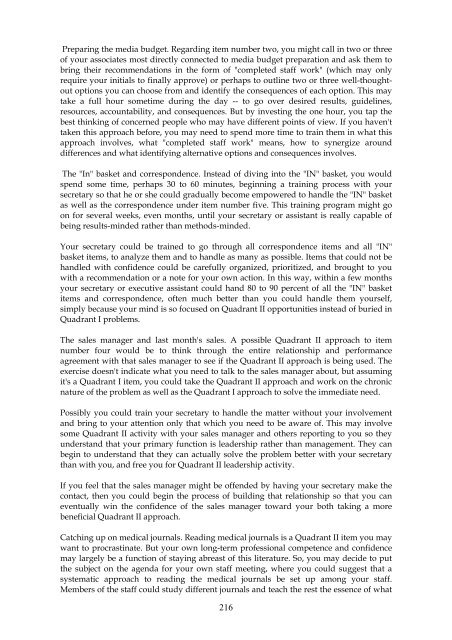Covey - The 7 habits of highly effective people
You also want an ePaper? Increase the reach of your titles
YUMPU automatically turns print PDFs into web optimized ePapers that Google loves.
Preparing the media budget. Regarding item number two, you might call in two or three<br />
<strong>of</strong> your associates most directly connected to media budget preparation and ask them to<br />
bring their recommendations in the form <strong>of</strong> "completed staff work" (which may only<br />
require your initials to finally approve) or perhaps to outline two or three well-thoughtout<br />
options you can choose from and identify the consequences <strong>of</strong> each option. This may<br />
take a full hour sometime during the day -- to go over desired results, guidelines,<br />
resources, accountability, and consequences. But by investing the one hour, you tap the<br />
best thinking <strong>of</strong> concerned <strong>people</strong> who may have different points <strong>of</strong> view. If you haven't<br />
taken this approach before, you may need to spend more time to train them in what this<br />
approach involves, what "completed staff work" means, how to synergize around<br />
differences and what identifying alternative options and consequences involves.<br />
<strong>The</strong> "In" basket and correspondence. Instead <strong>of</strong> diving into the "IN" basket, you would<br />
spend some time, perhaps 30 to 60 minutes, beginning a training process with your<br />
secretary so that he or she could gradually become empowered to handle the "IN" basket<br />
as well as the correspondence under item number five. This training program might go<br />
on for several weeks, even months, until your secretary or assistant is really capable <strong>of</strong><br />
being results-minded rather than methods-minded.<br />
Your secretary could be trained to go through all correspondence items and all "IN"<br />
basket items, to analyze them and to handle as many as possible. Items that could not be<br />
handled with confidence could be carefully organized, prioritized, and brought to you<br />
with a recommendation or a note for your own action. In this way, within a few months<br />
your secretary or executive assistant could hand 80 to 90 percent <strong>of</strong> all the "IN" basket<br />
items and correspondence, <strong>of</strong>ten much better than you could handle them yourself,<br />
simply because your mind is so focused on Quadrant II opportunities instead <strong>of</strong> buried in<br />
Quadrant I problems.<br />
<strong>The</strong> sales manager and last month's sales. A possible Quadrant II approach to item<br />
number four would be to think through the entire relationship and performance<br />
agreement with that sales manager to see if the Quadrant II approach is being used. <strong>The</strong><br />
exercise doesn't indicate what you need to talk to the sales manager about, but assuming<br />
it's a Quadrant I item, you could take the Quadrant II approach and work on the chronic<br />
nature <strong>of</strong> the problem as well as the Quadrant I approach to solve the immediate need.<br />
Possibly you could train your secretary to handle the matter without your involvement<br />
and bring to your attention only that which you need to be aware <strong>of</strong>. This may involve<br />
some Quadrant II activity with your sales manager and others reporting to you so they<br />
understand that your primary function is leadership rather than management. <strong>The</strong>y can<br />
begin to understand that they can actually solve the problem better with your secretary<br />
than with you, and free you for Quadrant II leadership activity.<br />
If you feel that the sales manager might be <strong>of</strong>fended by having your secretary make the<br />
contact, then you could begin the process <strong>of</strong> building that relationship so that you can<br />
eventually win the confidence <strong>of</strong> the sales manager toward your both taking a more<br />
beneficial Quadrant II approach.<br />
Catching up on medical journals. Reading medical journals is a Quadrant II item you may<br />
want to procrastinate. But your own long-term pr<strong>of</strong>essional competence and confidence<br />
may largely be a function <strong>of</strong> staying abreast <strong>of</strong> this literature. So, you may decide to put<br />
the subject on the agenda for your own staff meeting, where you could suggest that a<br />
systematic approach to reading the medical journals be set up among your staff.<br />
Members <strong>of</strong> the staff could study different journals and teach the rest the essence <strong>of</strong> what<br />
216


